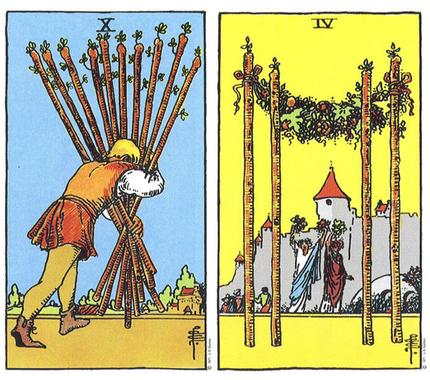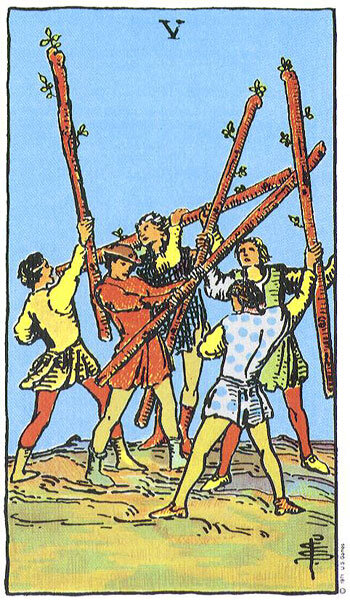In my book, Tarot and the Gates of Light: A Kabbalistic Path to Liberation, readers are asked to work with different 2-card combinations over the course of a 49-day traditional Kabbalistic ritual called Counting the Omer. Each combination of cards provides spiritual exercise leading to greater insight, helps people see the thought patterns that keep them from feeling fully connected to the Divine. I want to look at one of those pairs and how it connects directly to what we’re facing right now: the Seven and Five of Wands, which appears on Day 11 of the count.
When I wrote the book, oddly enough, I saw the man in the 7 of Wands as defending himself, not unlike the hero in Ibsen’s An Enemy of the People—this heroic doctor discovered that the mineral baths his town depended on for tourist income had become contaminated and was the source of disease. He was, in other words, a whistleblower for public and societal health. And because his information threatened people’s incomes, he was ostracized, his home vandalized, his family attacked. In this pair of cards that’s how I saw the man in the 7 of Wands: Now consider the man on the far left of the other card, the 5 of Wands, as this very same man, but here he is trying to get the attention of the others and bring them together even though they ignore him and continue in their pursuits and competitions that degrade the social structure.
If you’re wondering how I got here, I interpret the cards from the filter of their corresponding Sephira on the Kabbalistic Tree of Life. One of the many positive interpretations of Netzach includes Perseverance in the face of obstacles. Remember though, each Sephira has a negative side as well, and the image in the corresponding card may express that negative energy. The 5 of Wands is a Gevurah card, and one of the positive ways of looking at Gevurah is as structure, and organization. So that in looking at the 5 of Wands I see one of Gevurah’s negative expressions—social structure in disarray, where everyone wants to be the leader and acts only in self-centered concern. In this view the social structure, the social contract is breaking down.
And since I’ve noted that each Sephira has a positive and negative expression, alternately we can see the man in the 7 of Wands as not defending an unpopular opinion, but as someone who is simply out for himself—the destructive side of Ego, which is also one of the meanings of Netzach. And he’s not the only one. When we look at the 5 of Wands, we can see a group of people all out for themselves, in a social structure that is crumbling.
All you need to do to see this dark Sephirotic energy expressed in human action is to watch videos of the fist fights taking place in supermarkets all over the country as people rush to buy more toilet paper than they need or could possibly use.
Gevurah can represent the Social Contract—the altruism of people coming together to help each other in organized groups where everyone is respected. And in its negative expression, Gevurah can reveal a social structure atomizing into individual selfishness.
Let’s face it, in crisis situations we all have our flight, fight, freeze or faint mechanism that takes over even when it’s not appropriate or even necessary. While I’ve never fought anyone over a roll of toilet paper, I felt the rage rise up in me when someone took the last package of something I wanted at Trader Joe’s. It’s one of the emotions to observe as it arises, without acting it out or reacting. When I’m in a crowded supermarket where everyone is on the edge of panic, the real infection to be afraid of is that panic, which clouds our better judgment and our humanity. And in crowds, spreads like contagion.
In the days ahead, we are all going to face trials. Consider the selfishness of someone like former Miss Nevada, Katie Williams, whose response to the CDC asking people to stop going out tweeted: “I just went to a crowded Red Robin and I’m 30. It was delicious, and I took my sweet time eating my meal. Because this is America. And I’ll do what I want.”
This is a pathological individualism that doesn’t recognize our interdependence. “This is America, and I’ll do what I want.” Social distancing and the social contract be damned. Even if it leads to the deaths of thousands or millions.
She represents the negative side of Netzach in Gevurah—a pig-headed stubbornness in service of selfishness.
So far, we’ve considered two sides of Netzach in Gevurah in this paring of the 7 and 5 of Wands: Standing up against society for what’s right in an attempt to save that society out of the recognition of interdependence. Or standing up for a selfish individualism that sees no social obligation. The practice of Counting the Omer then asks us to see ourselves in all these situations, questioning our moral character at its deepest from every angle. Who would I be in this situation? How would I respond? Is there something of the other side that lives within me? In my past, who have I been in situations like these? What can I learn about myself, for better or worse?
There is one more way I would like to look at this pairing. And if you thought this last example was dark, I’m sorry. As I wrote, part of the way I interpret the situations I see in the cards is by inhabiting every angle and every character in the card, visible or not. My storytelling teacher and dear friend, Laura Simms, taught when you learn to tell a story, you can’t identify with one character or have a favorite. Otherwise you’re not letting the audience have its own experience or decide for themselves. And so in the 7 of Wands, rather than looking at the man on the hill who is beset by six unseen attackers as either a brave soul standing up against the crowd for what’s right, and rather than seeing him as someone who’s selfishness makes him unable to see his connection and interdependence with others, we can ask ourselves about the people (presumable they’re people, we don’t see them) who he appears to be defending himself against. Who are they, why are they attacking him—and are we in that group?
I remember how, in the early 80s and through the 90s (and truth be told even today) there were people who responded to the AIDS crisis by saying, this is God’s punishment against homosexuals for their sin. Combine this with another history further in the past but that I always live in cognizance of—in times of social upheaval and crisis, people look for a scapegoat. During the bubonic plague years between 1348 and 1351, a wave of anti-Jewish violence followed the plague in its wake. Jews were accused of starting the plague by poisoning the wells. By the close of the plague years in 1351, there had been 350 incidents of anti-Jewish pogroms and 60 major and 150 minor Jewish communities had been exterminated across Europe. In the last century, on the other side of the world, in the wake of the fires that followed the Great Kanto Earthquake in 1923, native Japanese turned on their Korean neighbors—some newspapers reported the accusation (not based in any fact) that Koreans were poisoning wells. Sound familiar? We humans have a limited imagination. It’s estimated that 10,000 Koreans were killed in anti-Korean violence and riots in Tokyo.
So it’s also easy for me to see the man in the 7 of Wands as the victim of persecution. And in the 5 of Wands, how in a weakened social structure it’s easy for a leader to turn people in a society, each against the other. Consider the figure on the far left of the 5 of Wands this time, rather than holding his wand up, trying to get the others attention and bring back order—from this angle I see him as egging on a fight. Today, the pastor of an evangelical church took 45, Orange Caligula, or whatever you want to call the sad excuse for a human in the White House, this pastor took him to task for calling COVID-19 the Chinese virus, saying that it fuels racism and discrimination, hate and violence. Of course, for Scump, that’s a feature, not a bug.
One of the things I tell people in the introduction to my book is that when you work with a pair of cards, since our journeys are all different, you may see other situations and find other meaningful lessons for your own life. And for this pairing in the book, what I wrote today I wouldn’t have thought of in the last few years on Day 11 when this pairing appears. Because not only are each of us different, each year we’re different, and circumstances are different. It’s what makes using the cards to Count the Omer such a rich practice for me.
And because the practice asks us to consider every experience that comes up from every side, I must look at not only my fears of persecution, but I also must look at my inner persecutor. Yes, I have to consider my inner Orange Caligula, see if anywhere in my life or in my thoughts I identify with or have hidden desires to be a persecutor, and when in my life I have been a persecutor.
I never said this was an easy practice.
This year, when I get to Day 11 of Counting the Omer, with the 7 and 5 of Wands I’m going to have a whole new set of questions to ask myself about my own courage and my own selfishness. This year, the Counting of the Omer begins on the evening of April 9th, the second night of Passover begins the first day of the Omer. And I’ll be counting online with either videos or my own daily thoughts and meditations, my inner questioning and insight. I hope you’ll join me.












